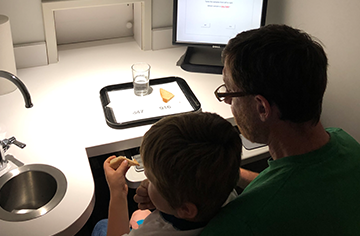Creating Low Sodium Bread to Serve in Oregon State Institutions
Download the story [PDF – 814 KB]

Watch more about how meal changes can improve health in correctional facilities.
Blood pressure is affected by many things, including what we eat. Foods high in sodium can increase blood pressure. High blood pressure, also known as hypertension, increases the risk of stroke, heart disease, and kidney disease.1 Prepackaged bread often contains high amounts of sodium to help extend its shelf life.2,3 Because many people in the United States eat bread every day, this excess sodium can make a big difference in blood pressure.
The Oregon Health Authority (OHA) sought to make institutional changes to the food it offers in schools, hospitals, and correctional facilities. OHA collaborated with local food scientists to develop a low sodium bread and test whether this healthier option would be received well by people at these institutions. The goal was for people at the institutions to eat and enjoy a low sodium option and integrate other healthy food selections into their diet.
Public Health Challenge
Foods that are high in sodium do not always taste salty. Many foods in U.S. adults’ daily diet have surprisingly high levels of sodium, which means that people could be eating more sodium than they realize. Bread is one of the largest contributors of sodium to the American diet, because added sodium increases bread’s shelf life.3,4 To address this issue in its state institutions, OHA decided to change the recipe for the bread used in its schools, hospitals, and correctional facilities. The goal was to develop a healthier alternative that contained less sodium.
Approach

Consumers test reduced sodium bread versus bread with typical sodium content at the Oregon State University Food Innovation Center.
OHA collaborated with the Oregon State University Food Innovation Center (FIC) to create bread recipes with different sodium levels and conduct consumer testing with these different recipes. The FIC created three different formulas for sandwich bread and hamburger buns: bread and buns with the same sodium levels currently served in statewide institutions, versions with 14% less sodium, and versions with 22% less sodium.
OHA and the FIC collaborated with Oregon State Hospital, the Oregon Department of Corrections, and the Oregon Department of Education to recruit children and adults to participate in the taste tests.
Results
The taste testers could detect a difference in the bread with 22% less sodium, but not the version with 14% less sodium. This result shows that the version of the sandwich bread with 14% less sodium could replace the sandwich bread that is currently being served without losing appeal to consumers.
Interestingly, most consumers liked the lowest sodium version of the sandwich bread more than the version with 14% less sodium and the original version. Similarly, consumers liked the hamburger buns with 22% and 14% less sodium better than the original version. These results indicate that replacing the sandwich bread and hamburger buns in statewide institutions with lower sodium versions would not only be accepted but preferred.
What’s Next
The consumer taste test provided encouraging evidence that people could enjoy eating lower sodium bread. One potential issue with reducing sodium in these bread products is a shorter shelf life. The FIC will conduct shelf-life testing for the products and work with the Department of Corrections to manufacture this lower sodium bread and distribute it to schools, hospitals, and correctional facilities across Oregon.
Offering lower sodium bread in Oregon schools, hospitals, and correctional facilities can reduce the risk of hypertension for people in these communities. This could also be an opportunity to show people that lower sodium foods can be healthier options without sacrificing taste.
Find Out More
Watch and learn how the Oregon Department of Corrections reduced sodium on a limited budget and learn more about the ingredients being used at Coffee Creek Correctional Facility in Oregon.
Read about Consumer Sensory Testing & Research services at the Oregon State University Food Innovation Center, the center helping to conduct taste testing on lower sodium foods.
Learn more about the Oregon Health Authority.
Use the SRCP Implementation Guide to apply sodium reduction strategies derived from the SRCP into your communities.
References
- CDC. High Blood Pressure Symptoms and Causes. Accessed August 8, 2021.
- World Action on Salt and Health. New WASH Survey Finds Huge and Unnecessary Variation of Salt Levels in Bread—WASH Urges Governments Worldwide to Take Action and Protect Health. Accessed August 8, 2021.
- Institute of Medicine (US) Committee on Strategies to Reduce Sodium Intake. Strategies to Reduce Sodium Intake in the United States: 4, Preservation and Physical Property Roles of Sodium in Foods. Washington, DC: Institute of Medicine. Accessed on August 8, 2021.
- CDC. Where’s the sodium? Accessed on August 8, 2021.
